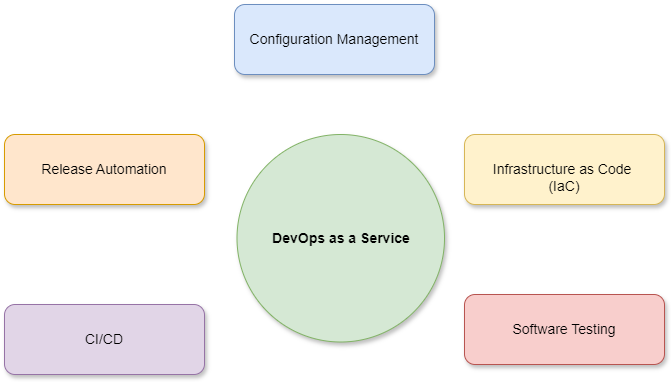DevOps-as-a-service (DaaS) is a way of delivering cloud services in the form of collaborative tools to help software developers and the rest of the engineers across organizations to work together. Under this model, the DaaS provider offers and integrates various essential tools to enable them to work together as one unit. This article takes a deep dive into DaaS, and its benefits, key challenges and future.
Understanding the Problem
As businesses look for quicker, more agile ways to build and deploy software that can adjust to market demands and user needs, you should be able to drive faster release cycles and offer better-quality products to lead the market. However, software development processes are prone to many inefficiencies and are often problematic for software projects with code revisions or changes, testing and deploying updates being the critical problem areas. The problems get aggravated when a lack of collaboration and communication between the team members hinders meeting project deadlines. Enter DaaS, an emerging trend that simplifies and streamlines the integration of development and operations.
What is DevOps? Why Does it Matter?
DevOps strives to close the divide between development and operations teams by combining cultural philosophies, tools and practices for enhanced cooperation and communication. As a result, an organization’s agility in software development improves, allowing it to create and deliver applications faster.
What is DevOps as a Service?
DaaS is a cloud-based paradigm that empowers development teams with the automation, tools and infrastructure required to effectively use DevOps techniques. DaaS is a cloud-based automated approach to DevOps that is changing the software development and IT operations landscape. This approach enables teams to streamline workflows, enhance collaboration and increase deployment frequency.
Typical examples of DaaS implementation are:
- Automated infrastructure management tools — Ansible and Terraform
- Cloud-based CI/CD pipelines — Azure Pipelines and AWS CodePipeline
- Monitoring and logging services — Splunk, Datadog, Prometheus, AWS CloudWatch and ELK Stack
Benefits of DevOps as a Service
The key benefits of DaaS are as follows:
- Enhanced Scalability: DaaS provides the ability to adapt to infrastructure and resources to meet project requirements as they evolve.
- Improved Software Quality: DaaS helps improve software quality by facilitating a CI/CD approach that can detect and rectify issues earlier in the software development life cycle. As a result, you can build high-quality, robust, stable and reliable software applications.
- Enhanced Communication and Collaboration: Leveraging DaaS tools can help facilitate communication and collaboration, closing the divide between organizations’ development, security and operations teams.
- Cost Optimization: Adopting a DaaS approach can reduce costs considerably by automating tasks that require manual effort.
- Security & Compliance: DaaS enforces regulatory compliance through integrated security measures from the beginning of the software development life cycle.
Key Components of DevOps as a Service
Effective DaaS implementation comprises multiple services working together to provide a streamlined software development environment. The key components of DaaS include the following:
Automation and Orchestration: DaaS services automate the building, testing and code deployment processes, freeing up valuable time for advanced strategies and ideas. Orchestration tools focus on automating workflows and integrating different parts of the software engineering culture. By automating manual tasks, DaaS minimizes errors, enabling teams to focus on more strategic tasks that add value to the business.
Infrastructure as Code (IaC): IaC allows organizations to manage their infrastructure using code. DaaS services provide on-demand infrastructure resources, such as virtual machines, containers and serverless architectures, with minimal operational overheads, enabling teams to rapidly provision and scale infrastructure based on application requirements.
This can reduce operating expenses and maintenance costs and provide much more stable and predictable environments with hardly any risks of configuration drift and deployment failure.
Continuous Integration and Delivery (CI/CD): A CI/CD pipeline reduces manual efforts throughout the DevOps life cycle by automating source code management, version control, testing and deployment. An organization with an adequately configured CI/CD pipeline can build, test and release software quickly with hardly any human intervention, drastically reducing application development costs while improving delivery speed, reliability and efficiency.
Monitoring and Performance Management: Organizations can address security issues proactively and prevent them by utilizing well-defined monitoring and logging mechanisms. A typical DaaS solution should have advanced monitoring, performance management, real-time analytics and user activity monitoring capabilities to provide real-time insights and track application and infrastructure performance.

Figure 1
Strategies for Successful Implementation of DevOps as a Service
Successful DaaS implementation in your organization entails alignment with the organization’s objectives and operational requirements. You should assess your business practices and workflows to confirm whether the DaaS solution perfectly complements your business needs and infrastructure.
You should begin by identifying areas that can benefit from introducing DevOps practices. Collecting opinions from stakeholders and identifying the pain spots can help you create a feasible and practical strategy to help achieve business goals and objectives.
Once your plan is ready, you should select the right provider, facilitate a collaborative culture in your organization and provide your team members with the necessary training to become familiar with DevOps principles and practices. Fostering a culture of collaboration will bring the most significant benefits from DaaS and help your organization achieve its business goals and objectives.
Future of DevOps as a Service
While fostering creativity and innovation, DaaS will be a key strategy for businesses in the future. Organizations must embrace it to promote automation, communication and collaboration, and ensure continuous advancement and sustained business growth. DaaS can leverage artificial intelligence (AI) and machine learning (ML) algorithms to empower teams to gain insights and make better data-driven decisions.
Conclusion
DaaS enables you to collaborate better, improve software quality, develop robust, secure, resilient apps and handle the complexities of deployment, infrastructure and performance. With security as the topmost priority from the outset and across the entire software development life cycle, organizations can leverage DaaS to implement strategies for protecting sensitive data and enforcing compliance with regulatory requirements.




